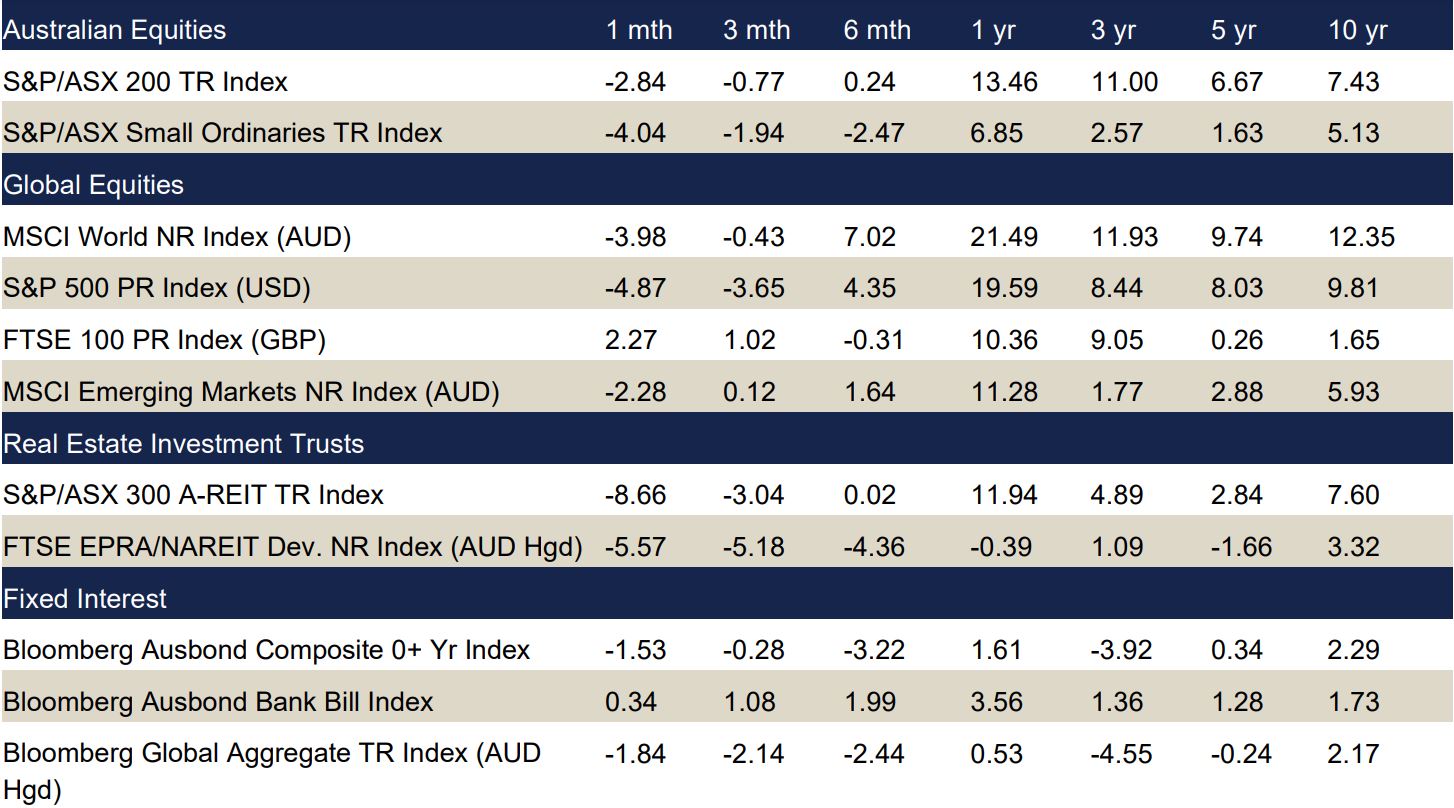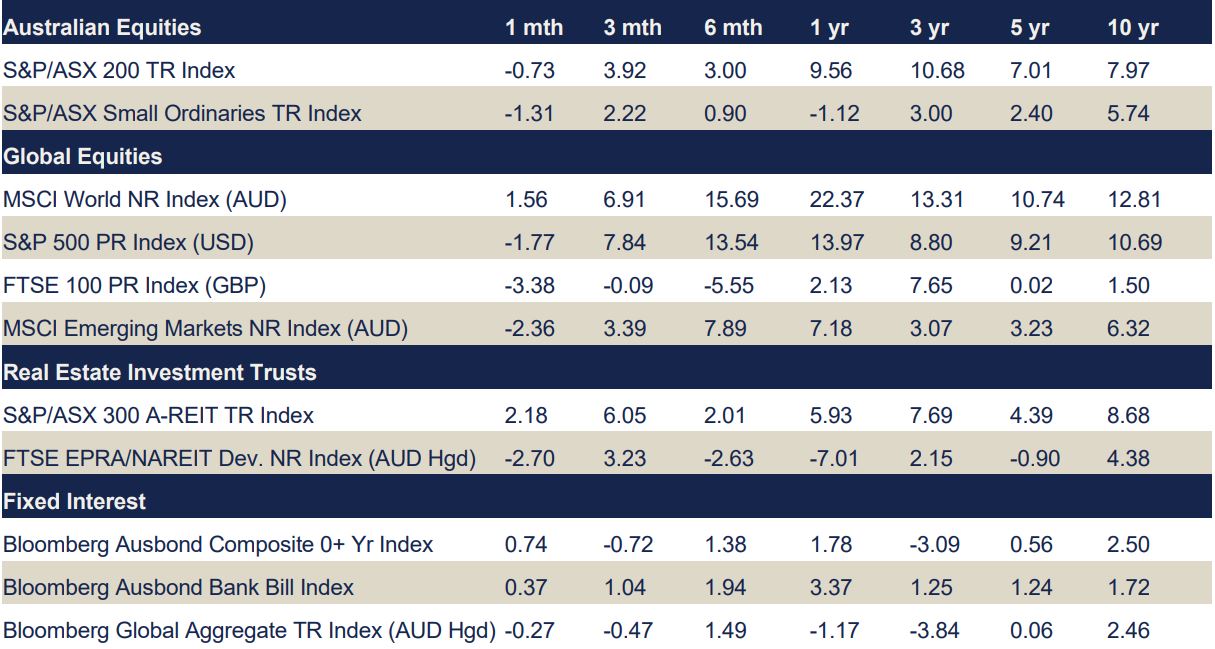
We all know them. The people who seem to know everyone and effortlessly make connections within their network. Let’s talk about a superpower we all can develop – being a connector.

We all know them. The people who seem to know everyone and effortlessly make connections within their network. Let’s talk about a superpower we all can develop – being a connector.


Data source: Bloomberg & Financial Express. Returns greater than one year are annualised.
Commentary regarding equity indices below references performance without including the effects of currency (unless specifically stated).
The ASX 200 finished September down 2.8%, reflecting the losses seen globally. Energy was the only gainer (1.6%), with all the other 10 sectors finishing the month in the red. The largest drops were seen in Real Estate (- 8.6%), Information Technology (-7.9%), and Healthcare (-6.2%). However, Australian equities did manage to outperform some global markets.
Energy was the lone bright spot in the market, returning 1.6%, riding the tailwinds of rising global oil prices. In terms of laggards, the Real Estate sector was hit hard with an 8.6% drop, reflecting the “higher-for-longer” rhetoric regarding interest rates, and the potential impact on property values.
Given the potential impact of interest rates on high growth tech stocks, IT was another sector seemingly hampered by the hawkish sentiment in September, suffering losses of 7.9%. This mirrored the sell-off in US tech giants such as Apple, Nvidia, and Amazon.
Global equities had a negative month, with September typically being the worst performing month historically for stocks. Emerging markets outperformed developed market counterparts returning -2.3% (MSCI Emerging Markets Index (AUD)) versus a -4.0% return according to the MSCI World Ex-Australia Index (AUD).
Continued negative economic data in September saw another rise in bond yields and a decrease in equity markets, with inflation falling slower than expected, primarily due to rising energy costs. US equities stumbled amid an interest rate hold and the prolonged possibility of a government shutdown, recording one of its worst months for the year with the S&P500 Index declining -4.8% (in local currency terms) during the month.
The UK was one of the few positive performers for the month, with the FTSE 100 Index returning a gain of 2.4% (in local currency terms). This was driven by a decrease in domestic core inflation and surprising GDP data above expectations. The Bank of England also kept interest rates on hold.
The S&P/ASX 200 A-REIT Accumulation index finished September lower after consecutive positive months in July and August, with the index finishing the month – 8.6%. Global real estate equities (represented by the FTSE EPRA/NAREIT Developed Ex Australia Index (AUD Hedged)) also fell, returning –5.3% for the month. Australian infrastructure finished lower through September, with the S&P/ASX Infrastructure Index TR returning -1.6% for the month.
In the month of September, M&A activity was relatively quiet. BWP Trust (ASX: BWP) announced the divestment of their Wollongong property to an unrelated third party for $40mn. In broader news Charter Hall (ASX: CHC) announced their new CFO, Anastasia Clarke, following the resignation of former CFO Russel Proutt. Cromwell Property Group (ASX: CMW) announced the resignation of their CFO Michael Wilde and are yet to announce a replacement.
The Australian residential property market experienced an increase by +0.9% Month on Month (as represented by CoreLogic’s five capital city aggregate). Adelaide was the largest riser (+1.7%), followed by Brisbane and Perth (both +1.3%). All five capital cities performed positively for the fifth consecutive month with Melbourne (+0.4%) being the worst performing city. Over the one-year period, Perth was the largest gainer (+8.8%).
In his final meeting as RBA Governor, Phillip Lowe kept the cash rate on hold at 4.10% for the third month running. This month’s meeting signifies Lowe’s final monetary policy decision hand down, with his seven-year term not being renewed. During his term, Lowe and the RBA board cut rates to a historic 0.1 percent, and subsequently hiked rates 12 times in a bid to control inflation. Lowe’s successor, Michele Bullock, took over the role on September 17.
The month saw a sharp repricing of bond markets with yields rising to cycle highs. Australian 2- and 10- Year Bond yields rose 25bps and 46bps respectively, and the Bloomberg AusBond Composite 0+ Yr Index returned – 1.53%. Despite inflation rates falling and economic data showing a slowing economy, bond markets appear to be repricing due to concerns central banks are expected to maintain higher interest rates for a prolonged period.
The story was similar in the US, with the Federal Reserve holding the target cash rate steady at 5.25%- 5.50% citing easing inflation pressures and concerns of slowing economic growth. Despite the rate hike respite, bond markets experienced a poor month, correlating positively with equity markets. US 2- and 10- Year Treasury yields rose 18bps and 46bps respectively, and the Bloomberg Barclays Global Aggregate Index (AUD) returned -2.58% over the course of the month.
The RBA held the cash rate at 4.1% in September, reserving the need for increases in the coming months to ensure that inflation returns to target in a reasonable timeframe. Inflation unexpectedly rose to 5.2% in August with the most significant rises in housing, transport, food and insurance.
The Westpac-Melbourne Institute Index of Consumer Sentiment fell to 79.7 in September, with pessimism persisting, despite easing fears of further interest rates. The unemployment rate was steady at 3.7% in August, matching market forecasts. Retail sales increased by 0.2% in August, below the market estimate of 0.3%, while annual sales rose 1.5%. These figures indicate that consumers continue to rein in spending as interest rates remain elevated.
Composite PMI increased to 50.2 in September, the highest figure in four months, indicating a return to expansion for the private sector. The NAB business confidence index came in at 2 in August with sentiment mixed across industries and falling sharply in mining.
The World Bank has maintained its forecast for China’s 2023 economic growth at 5.1% in line with its previous estimate in April. Their predictions were trimmed for 2024 to 4.4 per cent from 4.8 per cent, citing the persistent weakness of its property sector.
The US Federal Reserve held interest rates steady at 5.25- 5.5% but released an updated “dot plot” for their future trajectory which proved more hawkish than previous expectations. Many policymakers anticipate one further 0.25% increase in the remainder of 2023, and the median expectations are for only 0.5% in rate cuts through calendar 2024, compared to double this level indicated in the last dot plot. Accompanying commentary confirmed that the Fed now sees the battle to return inflation to its 2% target stretching out to 2026. Annual inflation rose to 3.7% in August, above the expected 3.6%.
The US economy added 336,000 jobs in September, nearly double the anticipated 170,000. The unemployment rate was static at 3.8% in September. The labour market remains tight, adding leeway for the Federal Reserve to leave borrowing costs at restrictive levels for a prolonged period.
Consumers remain unsure about the economic outlook with consumer confidence edging up to 68.1 in September, but below the high of 71.6 in July. Retail sales in August increased 0.6%, beating the 0.2% forecast, with the annual rate increasing by 2.5%. The S&P Global Composite PMI fell to 50.1 in September, the fourth consecutive decline, suggesting broad stagnation in the private sector. The trade deficit narrowed to US$58.3 billion in August, better than the forecast US$62.3 deficit.
The European Central Bank raised interest rates to 4.5%, the 10th consecutive rise. This signals a possible end to policy tightening, as inflation has started to decline but is still expected to remain too high for too long.
Annual inflation fell to 4.3% in September, below the market consensus of 4.5%. The ECB forecasts average inflation at 5.6% in 2023 and 3.2% in 2024, both higher than previous estimates, primarily due to an elevated path for energy prices. PPI rose 0.6% in August, in line with market expectations, with the annual rate falling 11.5% as energy costs continue to fall.
Unemployment came in at 6.4% for August, matching the market forecast. Consumer confidence dropped to -17.8 in September, as households remain pessimistic about both their own and the wider economic outlook. Retail sales dropped 1.2% in August, compared with market expectations of -0.3%, with the annual rate down 2.1%, below the anticipated -1.2%. The Composite PMI rose to 47.1 in September, with a steep contraction in the manufacturing sector.
The Bank of England held rates at 5.25% in September as policymakers opted for a wait-and-see approach, with inflation and labour data suggesting the accumulated impacts of previous policy tightening might be taking effect.
Annual inflation eased to 6.7% in August, below the expected 7.0%, primarily due to the slowdown in food inflation. PPI fell by 0.4% in August, compared to market expectations of a 0.6% decline.
The unemployment rate increased to 4.3% in July, slightly above expectations, indicating that the labour market may be cooling off after months of unprecedented monetary policy tightening by the Bank of England.
Consumer confidence rose to -21 in September, above the expected -.27, amid growing optimism about the economy and easing pressures on household spending. Retail sales rose 0.4% in August, just below the market forecast of a 0.5% increase. Annual sales fell by 1.4%, more than the expected 1.2%.
The composite PMI index fell to 46.8 in September, driven by the continued contraction in manufacturing and a steep decline in the services sector.
The unemployment rate dropped to 5.2% in August, matching June’s 16 month low of 5.2%.
Annual inflation came in at 0.1% in August, below market expectations of 0.2%, with core inflation increasing 0.8%. Annual Retail sales grew 4.6% in August, exceeding market estimates of 3.0%.
Composite PMI fell to 50.9 in September, as new orders rose at a softer pace with manufacturers and service providers recording only marginal increases in sales.
This suggests the downturn in growth may be stabilising, but real estate remains a weak spot in the economy with property investment falling 8.8% in 2023.
The Bank of Japan maintained its key short-term interest rate at -0.1% and that of 10-year bond yields at around 0% in its September meeting by unanimous vote.
The annual inflation rate fell marginally in August to 3.2% just below the market forecast of 3.3%.
The unemployment rate was unchanged at 2.7% in August, above the market prediction of 2.6%.
The consumer confidence index dropped to 35.2 in September, with sentiment dropping across all components. Retail sales rose 0.1% in August, with the annual rate rising 7.0%, above the forecast 6.6%.
The composite PMI came in at 52.1 in September as services activity grew the least in eight months, while factory output fell at the fastest pace for three months.
The Australian dollar (AUD) appreciated over the month of September, closing 0.8% higher in trade weighted terms to 61.1, strengthening against the Pound Sterling (GBP), Euro (EUR) and the Japanese Yen (JPY) whilst depreciating against the US Dollar (USD).
Volatility continued throughout the month, primarily influenced by relative US strength driven by US Employment data, shifting US bond yields and messaging from the Fed’s September meeting. Additionally, the AUD was influenced by economic indicators from China such as a slump in Caixin China Services PMI.
Relative to the AUD, the USD led the pack in September, appreciating by 0.5%. Conversely, the GBP was the laggard of the month, depreciating in relative terms by 3.2% against the AUD. Year-on-year, the AUD remains behind the GBP and EUR by -8% and -6.8%, respectively, whilst ahead of the USD and JPY by 0.6% and 3.7%, respectively.

This article will help to ease some fears about market volatility and outline a behavioural approach to address emotional decision-making. Hopefully, this information will assuage fears that many investors have experienced over the past several months.

Like any other insurance policy, life insurance has many variations to meet different users’ needs. Thus, before choosing one, you must determine what you need in a life insurance policy.

Being named the executor of an estate is both an honour and a burden. Entrusted with this pivotal role, one carries out the last wishes of a loved one, but the path is often strewn with complexities and unforeseen challenges.
At first glance, the executor’s role might seem straightforward. However, in practice, it’s a demanding role that requires interaction with a myriad of entities, such as banks, real estate professionals, utility companies, the deceased’s superannuation fund, and the taxation office.
Furthermore, an executor’s duties are vast and varied. They encompass everything from overseeing funeral procedures, securing the death certificate, and notifying friends and family about the loss. They’re also tasked with locating the will, identifying beneficiaries, gathering a multitude of documents, settling estate debts, documenting estate assets, and initiating insurance and superannuation claims.
For those in the process of drafting a will and designating an executor, a few proactive steps can immensely assist in the estate’s efficient management:
Collaborate with a knowledgeable probate lawyer or solicitor specialising in wills and estate management. Their insights can be invaluable, especially regarding local family and inheritance laws.
Given life’s unpredictability, regular updates to your will, insurance policies, and superannuation death benefit details are paramount.
It’s crucial to note that superannuation doesn’t fall within your estate and isn’t addressed in your will. Still, you can specify your wishes and arrangements concerning your super death benefit nominations in your will.
Seek guidance from your financial adviser and super fund to establish death nominations, thereby streamlining benefit acquisitions for beneficiaries.
If feasible, contemplate liquidating your entire death benefit from the super fund while still alive. This proactive step allows for immediate distribution based on your directives or deposits into a bank account, providing easy access for the executor upon your passing.
If you’re ever nominated as an executor by a loved one, it’s prudent to discuss these considerations with the person who drafted the will (the Testator). Collaboration with their legal advisor (and financial consultant if available is also advisable to ensure a comprehensive understanding of the responsibilities and challenges ahead.
The role of an executor is multifaceted, rife with both honour and intricate challenges. However, with a well-charted roadmap and diligent preparation, the process can be streamlined, ensuring a smoother transition for all involved.
This can be a complex discussion and should be undertaken with a trusted advice professional. Reach out to the Sherlock Wealth team here to get started.
Source: Matrix Planning Solutions
This information does not take into account the objectives, financial situation or needs of any person. Before making a decision, you should consider whether it is appropriate in light of your particular objectives, financial situation or needs.

The complexity of farm succession planning extends beyond mere financial transactions. For farm owners, navigating the transition of a generational asset such as a farm is both an economic and emotional endeavour. The process often grapples with uneven asset distribution, potentially leading to family strife if not managed well.
A typical farm usually constitutes the lion’s share of a farming family’s assets. However, the farm’s income is often adequate to sustain just one family. Consequently, when the time comes to hand down the farm, usually, one child becomes the inheritor.
Life is unpredictable, and the untimely demise of a parent can throw succession plans into disarray. Here, life insurance can serve as a financial cushion, providing immediate liquidity to manage an unplanned succession.
What sustains the parents after they step back? Ideally, they would live on the off-farm assets accumulated over the years. However, the reality is often a mix of income streams, such as leasing arrangements and continued payments from the farm. This is not always convenient for the next generation, who may prefer to invest in the farm rather than pay their retired parents. Moreover, assuming ownership may require the new generation to shoulder existing debts and potentially accrue new ones to buy out their parents.
Farm succession planning is more than just a financial transaction; it is an emotional and familial journey that requires collective decision-making. Initiating the process early and involving all family members can alleviate potential pitfalls. A balanced approach can help navigate the complexities and ensure the farm remains a generational asset while still considering the needs and feelings of every family member.
Reach out to our experienced advice professionals to discuss your unique situation here.
Source: Matrix Planning Solutions
This information does not take into account the objectives, financial situation or needs of any person. Before making a decision, you should consider whether it is appropriate in light of your particular objectives, financial situation or needs.

The investment technique known as ethical investing prioritises the investor’s moral, religious and social ideals over financial gain. This is because a growing number of investors have begun to demand social responsibility from the companies they invest in, primarily because of the rise in dubious and unlawful investment arrangements.

In today’s society, the notion of wealth extends beyond financial resources. As individuals seek a more balanced and fulfilling life, the concept of wealth has evolved to encompass various factors such as education, healthcare, job satisfaction, and social connections. This article explores the changing perception of wealth in contemporary Australia and highlights the importance of holistic well-being in defining prosperity.


Data source: Bloomberg & Financial Express. Returns greater than one year are annualised.
Commentary regarding equity indices below references performance without including the effects of currency (unless specifically stated).
The S&P/ASX 200 Accumulation Index fell 0.7% in August, as earnings results dampened market returns. Of the 11 sectors, only Consumer Discretionary (+5.7%), Property (+2.3%) and Energy (+0.5%) had positive returns for the month, while Utilities (-3.9%) and Consumer Staples (-3.2%) were the biggest drags on the Index.
Share prices battled with a combination of mixed earnings results and a conservative outlook for companies, while soft economic data out of China continued to weigh on local investors.
Consumer Discretionary was the standout performer for the month, benefiting from resilient consumers. Given the continued strain on households through a higher cost-of-living, many companies in the sector had flagged headwinds in the months leading into reporting season, with a conservative outlook already baked into share prices. Another theme to emerge from earnings reports is the ability for companies to manage cost pressures, particularly those brought about through higher financing rates. Despite revenue growth, Consumer Staples reported disappointing profit results, leading to their waning share prices. More broadly, the sustained impact of a slowing Chinese economy was seen across the market, particularly Materials.
The month saw all Factors perform negatively. Enhanced Value (-3.1%) and Low Volatility (-2.5%) were the worst performing factors, while Growth was able to limit its losses (-0.4%).
Primarily negative economic data in August resulted in a rise in bond yields and a decrease in equity markets. With renewed investor concerns, US equities stumbled with the S&P500 Index declining -1.6% (in local currency terms) during the month.
Most sectors across Europe fell, with the DAX 30 Index returning -3.0% (in local currency terms) for the month. Energy was one of the sole positive contributors, inflation has remained stable but is yet to decline below previous months’ levels. The European Central Bank’s next meeting will be a watchpoint for investors.
China experienced some of the sharpest declines for the month with a potentially challenged real estate sector. Investor concerns around stimulus deployment largely contributed to this decline, with the CSI 300 Index returning -6.0% for the month (in local currency terms). In Hong Kong, stocks fell sharply with weaker manufacturing and real estate market concerns in surrounding markets. This was reflected in the Hang Seng Index returning -8.2% for the month (in local currency terms).
The S&P/ASX 200 A-REIT Accumulation Index finished +2.3% higher in the month of August as the A-REIT sector continued its consolidation in recent months. In contrast, the Global Real Estate Equities market (represented by the FTSE EPRA/NAREIT Developed Ex Australia Index (AUD Hedged) finished lower (-2.7%). The Australian Infrastructure sector (as represented by the S&P/ASX Infrastructure Index) finished -2.8% lower.
In the month of August, M&A activity was relatively muted as companies reported their full year results. Abacus Group (ASX: ABG) officially completed its de-stapling from Abacus Storage King (ASX: ASK). Ingenia Communities Group (ASX: INA) extended their development partnership with Sun Communities for an additional seven years. Meanwhile, Goodman Group (ASX: GMG) reported that Senko Co Ltd. signed a major lease agreement at their Goodman Joso location in Japan. The Australian residential property market experienced an increase by +0.1% Month on Month (as represented by CoreLogic’s five capital city aggregate). Brisbane was the biggest riser (+1.5%), followed by Adelaide (+1.1%). Over the one-year period, Perth was the largest gainer (+4.5%). In contrast, Hobart (-0.1%) was the only city to deliver negative returns in the month of August. Similarly, Hobart has the lowest percentage change year on year (-10.0%).
In their August meeting, the Reserve Bank of Australia have for the second time elected to pause rate hikes and leave the target cash rate at 4.10%, citing slowing economic growth and pressure on household budgets. The Australian bond market reacted mildly, with Australian 2- and 10- Year Bond yields falling 23bps and 3bps respectively over the course of the month.
The Australian yield curve continued to flatten throughout August, and the Bloomberg AusBond Bank Bill Index returned 0.37%. Markets are expecting a similar story in September, with the RBA expected to hold rates steady next month. RBA Governor Philip Lowe’s tenure will soon end, and the position will be headed by his deputy Michele Bullock.
In the US, the Federal Funds Rate remains at 5.25%- 5.50% following the most recent July rate hike, with the Fed’s first-rate cut being priced into futures contracts by March 2024. The Bloomberg Barclays Global Aggregate Index (AUD) returned 2.62% over the month, and US 2- and 10-Year Treasury yields rose 1bp and 15bps respectively. In the UK, the interest rate is at 5.25% after the BoE hiked by 25bps in their August 2 meeting, resulting in UK Gilt yields rising over the month.
Australian GDP came in slightly above expectations, increasing at an annual rate of +2.1% for the 12 months to June, despite very weak household consumption.
GDP growth has slowed from +2.4% to March, consistent with the RBA’s forecast for a continued softening of the domestic economy into the end of this calendar year before a gradual recovery through 2024 and 2025.
The RBA left the cash rate at 4.1% in August, reiterating that inflation was still too high and further tightening may be needed to bring inflation back to its target range of 2-3%. Inflation unexpectedly eased down to 4.9% in July, led by falling prices for fresh produce and fuel.
Westpac-Melbourne Institute Index of Consumer Sentiment came in at 81.0 in August, ahead of expectations of 80.7 with the RBA’s decision to hold rates steady for a second month in a row, doing little to quell worries about higher borrowing costs. The unemployment rate rose to 3.7% in July, above the expected 3.6% and underscoring the RBAs prediction that the labour market is near a turning point. Retail sales increased by 0.5% in July, topping market estimates of 0.3%, while annual sales rose 2.1%.
The composite PMI edged down to 48 in August, with services activity falling at a faster pace than manufacturing output. The NAB business confidence index rose to 2 in July with wholesale, construction and recreation & personal services accounting for most of the upswing.The trade surplus narrowed to $8.04 billion in July, below market forecasts of $10 billion.
Record temperatures in August drove food prices higher with soybeans, olive oil and rice just three of the products affected by shortages and price hikes. While seasonal price fluctuations are usual, the exceptionally hot and dry summer experienced in the northern hemisphere has caused poor harvests and many crops to fail.
The war in Ukraine also continues to impact the global food supplies, as the UN brokered deal for safe passage of Ukrainian grains via the Black Sea collapsed, with Russia pulling out of the agreement. While some grain is still being exported via inland rivers, it takes longer and is more expensive than via sea.
The US economy grew at an annualized rate of 2.1% in 2Q23, ahead of the first quarter’s expansion of 2.0%. Annual inflation rose to 3.2% in July, just shy of the expected 3.3%.
The US economy added 187,000 jobs in August, more than market expectations of 170,000. This is the third month of sub 200,000 jobs growth and coupled with the increase in unemployment to 3.8%, suggests that the year of successive rate rises by the Fed is working to get inflation under control and avert a recession.
Consumers remain tentative about the outlook ahead with consumer sentiment falling from 71.6 in July to 69.5 in August. Retail sales in July increased 0.7%, beating the 0.4% forecast, with the annual rate increasing 3.2%. The S&P Global Composite PMI fell to 50.4 in August, with services activity weak and the contraction in manufacturing deepening.
The trade deficit widened less than expected to US$65 billion in July, from a downwardly revised US$63.7 billion in June, with China accounting for US$24 billion of this figure.
The Eurozone economy grew by 0.6% in 2Q23, easing from a 1.1% expansion in the previous period, due to the large drop in real incomes and surging interest rates.
Annual inflation remained steady at 5.3% in August, above the expectations of 5.1%. Unemployment stayed at the record low of 6.4% for July, matching the market forecast.
Consumer confidence dropped to -16 in August, as households were more pessimistic about both their own and the wider economic outlook.
Retail sales dropped 0.2% in July, below market expectations of – 0.1%, with the annual rate down 1.0%, ahead of the anticipated -1.2%.
The Composite PMI dropped to 46.7 in August, with the biggest contraction in services activity since November 2020. PPI dropped 0.5% in July, broadly in line with expectations, with the annual rate falling 7.6%. This can be attributed to the decrease in energy prices.
The Bank of England increased the cash rate by 25bps to 5.25% in August, the 14th consecutive rise. The Bank came under renewed pressure to raise interest rates again in September after wages jumped more than expected in June, boosted by a one-off payment to NHS workers.
Annual inflation slowed to 6.8% in July, matching market expectations, mainly due to a sharp fall in fuel prices. This was mirrored in the annual PPI which fell be 0.8% in July, below the market expectations.
The unemployment rate increased to 4.2% in June and above market expectations of 4.0%.
Consumer confidence rose to -25 in July as easing inflation reduced pressure on household spending sentiment. Retail sales fell 1.2% in July 2023, worse than market forecasts of a 0.5% fall, as sales declined for both food and non-food, reflecting the impact of wet weather and cost pressures. Annual sales fell 3.2%, compared to the expected -2.1%.
The composite PMI index fell to 48.6 in August with both services and manufacturing activity declining.
In China, the unemployment rate rose to 5.3% in July, up from June’s 16 month low of 5.2%.
Annual Retail sales grew 2.5% in July, down from 3.1% in June and falling short of expectations. Both consumer and business confidence are flagging as the post pandemic recovery has stalled and many believe that policymakers have fewer good options to fight the downturn than in the past.
The Caixin/S&P Global Services PMI fell from 54.1 in July to 51.8 for August, the lowest reading since pandemic lockdowns in late 2022. The Composite PMI declined to 51.7, adding to the recent series of negative signals for the country’s future demand for Australian mining commodities.
China lifted anti-dumping tariffs on Australian barley in a move that points to improving bilateral relations and would alleviate supply concerns after Russia suspended a humanitarian corridor used to deliver key Ukrainian grains to global markets.
Japan’s 2Q23 GDP was slightly below expectations, coming in at 1.3% for the quarter, which may give further justification for the BOJ to relax its monetary stimulus.
The annual inflation rate was unchanged at 3.3% in July, notably higher than the market forecast of 2.5%.
The unemployment rate rose unexpectedly to 2.7% in July, defying market forecasts of no change from 2.5% in June.
The consumer confidence index dropped to 36.2 in August, below forecasts of 37.5. Retail sales rose 2.1% in July, with the annual rate rising 6.8%, exceeding forecasts.
The composite PMI came in at 52.6 in August with the fastest rise in services activity in three months offset by weakness in manufacturing production.
The Australian dollar (AUD) continued to descend over the month of August, closing -1.1% lower in trade weighted terms to 60.6, depreciating against all four referenced currencies in this update.
Volatility over the course of the month continued to be primarily influenced by weaker economic indicators from China, further eroding investor conviction in China’s growth trajectory. In addition, relative US dollar strength predominantly stemming from the appreciation of the USD/CNY mid-month added additional drag to the AUD.
Relative to the AUD, the US dollar (USD) led the pack in August, appreciating by 3.8%. Conversely, the Japanese Yen (JPY) was the laggard of the month, albeit appreciating in relative terms by 1.5% against the AUD. Year-on-year, the AUD remains behind the Pound Sterling (GBP), Euro (EUR) and USD by -13.4%, -12.5% and -5.6% respectively, and has now fallen behind the JPY by -1.0%.